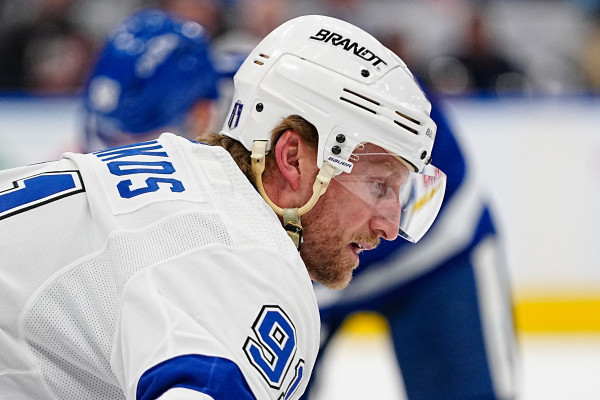
NHL Off-Season Outlook: Did the Tampa Bay Lightning Weather the Cap Storm?
The clock is ticking for Tampa Bay's competitive window with aging veterans and a salary cap crunch, but they are still a playoff team, writes Adam Proteau.

This is the latest file in THN.com’s “off-season outlook” feature, in which we take a look at every NHL team’s 2022-23 season, in addition to analyzing the team’s strengths and weaknesses heading into the 2023-24 campaign. We’ve been breaking down teams in alphabetical order, and today, we’re focusing on the Tampa Bay Lightning.
2022-23 Grade: B
Biggest Positive Heading Into the Off-Season
It’s been an exhilarating few seasons for the Lightning, who had won two consecutive Stanley Cup championships, as well as a Cup final appearance, in the three seasons leading up to the 2022-23 season.
However, the grey cloud in that competitive silver lining is the amount of wear-and-tear Tampa’s core of talent had to deal with last season. In the end, that grind was the reason why the Bolts fell to the Toronto Maple Leafs in six games of the first round. Stars Victor Hedman and Andrei Vasilevskiy looked especially worn down against Toronto, and Vasilevskiy could no longer steal games the way he did in the preceding years.
All-in-all, it was a disappointing year for Bolts fans accustomed to regular-season dominance and playoff glory. But GM Julien BriseBois has assembled a core that remains relatively intact for the coming year.
There are still stars Steven Stamkos, Nikita Kucherov, Brayden Point and Mikhail Sergachev, a healthier Hedman and Vasilevskiy with a summer of rest, and tremendous role players such as Anthony Cirelli and Brandon Hagel. That’s a very solid group.
The loss to the Leafs was a sobering reminder to the Lightning that the line between winners and losers is paper-thin. The window to win is starting to close for many Tampa players, but that should add a sense of urgency in 2023-24. They certainly should be a playoff team once again, and from there, the pressure will be on to improve on last season's results. But they do have the horses to once again be a serious Cup threat.
Biggest Need Heading Into the Off-Season
After the Bolts’ salary cap crunch this summer, their depth on the wing took a hit with the departure of key contributor Alex Killorn in free agency. They also lost some ruggedness when the cap crunch forced BriseBois to trade winger Pat Maroon to Minnesota.
Even then, the Lightning are more than $6.57 million over the cap ceiling, according to PuckPedia. That will change when defenseman Brent Seabrook’s salary is shifted to the long-term injury reserve, but that leaves BriseBois with just $297,500 to address any in-season needs.
Don’t be surprised if Tampa Bay trades for more support players during the year. In addition to the loss of Killorn, the Bolts also said goodbye to veteran forwards Ross Colton, Corey Perry and Pierre-Edouard Bellemare this summer, so it’s clear what area BriseBois will be seeking to bolster.
Their defense may require some help during the season, as they don’t have the depth to deal with injuries. But for the most part, Tampa’s bottom six forwards are the part of the team Lightning management must focus on once the season begins.
Bottom Line for Tampa Bay This Off-Season
Stamkos, Hedman and Kucherov all are in their 30s now, and although there probably will be no notable drop-off in their performance, the Lightning still need them to carry a lot of water for this team to be successful.
For the first time in a long time, they may have their playoff position challenged by up-and-coming Atlantic Division teams in Detroit, Ottawa and Buffalo, but so long as Vasilevskiy is healthy and able to play 60 games like last season, the Bolts are going to be a tough opponent for any team.
All the mileage Tampa Bay has accumulated in their recent success has taken a major toll on their roster, but there’s too much skill and experience in their lineup for them not to qualify for the next post-season. The problem at that point will be going to battle with younger, deeper teams – like the Leafs were last season – and finding ways to win games when they count the most. That problem sunk their battleship in 2022-23, and it could do the same thing again this coming year.